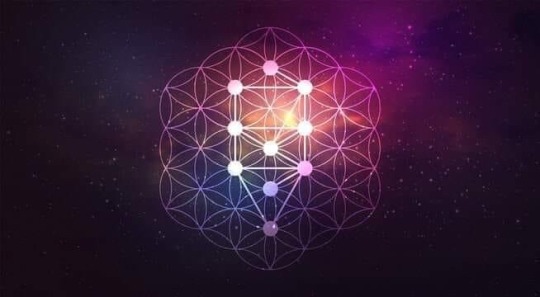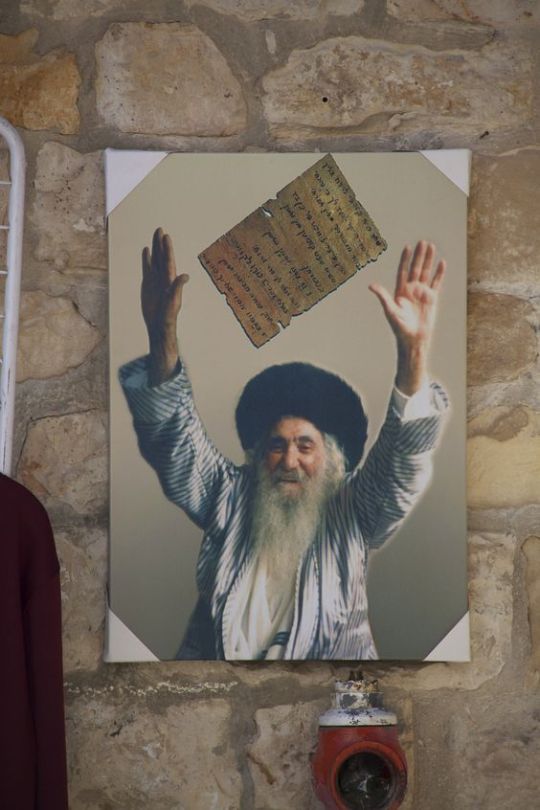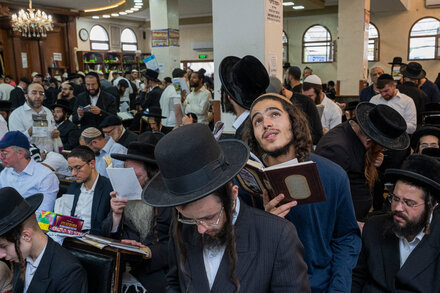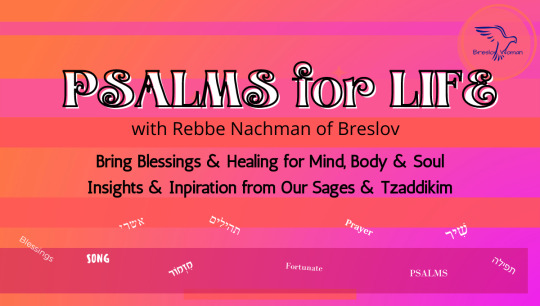#Rebbe Nachman of Breslov
Text
When in doubt, don't overthink
Life is a series of tests. No, not the kind we take in school. The kind in which we have to make a choice and hope that the choice in front of us is the best possible solution in a given situation. At times, it is important to confront our problems with a multi step approach in which we try to imagine the results of several possible outcomes before choosing the “best” approach as we see it. Of…

View On WordPress
#analysis paralysis#doubt#growth#journeying forward#Likkutei etzos#Likkutei Etzot#new beginnings#new beginnings spiritual coaching and consulting llc#overthink#problem solving#Rebbe Nachman of Breslov#Rebbe Nachman&039;s advice#spiritual growth#Spirituality
0 notes
Text
WATCH VIDEO: Tikkun Haklali & Happiness-Psalms for Life
WATCH VIDEO: Tikkun Haklali & Happiness-Psalms for Life
See previous chapters of Psalms for Life playlist: https://www.youtube.com/playlist?list
In Psalms for Life, a weekly 30 minutes class, we’ll explore the historical, spiritual and textual richness of the Book of Psalms with Breslov insights and more. At the end of each class we will recite Psalms together as a merit for anyone seeking a Refuah Sheleimah, a complete healing/recovery. Visit…

View On WordPress
#ashreinu#Breslov Classes and Events#Breslov for women#Breslov Woman#Chaya Rivka Zwolinski#depression#happiness#Joy#personal growth#Prayer#Psalms#Reb Nasan#Reb Noson#Rebbe Nachman#Tehillim#Tikkun Haklali#video
3 notes
·
View notes
Text
The Tiqqun HaKlali (General Remedy) of Rabbi Nachman of Breslov from the Open Siddur Project
#Tikkun HaKlalli of Rabbi Nachman of Breslov#The Tiqqun haKlali of Rebbe Naḥman of Bratslav#General Remedy#Open Siddur Project#Jewish Studies#Prayer & Adoration#Bookshelf#Tumblr Staff Has Ruined Links Now And I Hate Them For It
0 notes
Text
If you believe that you can damage, believe that you can fix. If you believe that you can harm, then believe that you can heal.
- Rebbe Nachman of Breslov
262 notes
·
View notes
Text
(JTA) — As we mark the grim second anniversary of the Ukraine conflict this Shabbat, I’m reminded of a haunting melody I heard in the city of Poltava last month.
I was standing before Sonia Bunina, a plucky 17-year-old, when she opened her mouth to sing when an air raid siren rang out.
I flinched. Not Sonia — she didn’t miss a beat.
“Kol haolam kulo gesher t’zar meod, veha’ikar lo lifached k’lal,” she belted out before seeking shelter. “The whole world is a very narrow bridge, and the most important thing is to have no fear at all.”
Sonia, like so many Jews I know in Ukraine, is many things — determined, grieving, focused — but she’s certainly not cowering.
As she sang those words by Rebbe Nachman of Breslov — the Ukrainian Jewish sage whose followers continue to come by the tens of thousands to his grave in Uman annually — she embodied the prayer’s indomitable spirit.
Sonia and I met outside Poltava’s Hesed, part of the network of Jewish humanitarian hubs founded by my organization — the American Jewish Joint Distribution Committee, or JDC — more than three decades ago. Today they’re a lifeline to tens of thousands of Jews facing loss and strife. Since she was a toddler, Sonia has been attending activities at Hesed — her mother coordinates cultural programs for the elderly, and she connects teen volunteers like herself with isolated seniors, a critical source of comfort these last two years.
These days, traveling to Ukraine feels like a pilgrimage — there’s a pull in my soul to visit family near Lviv, to bear witness to Ukrainian Jewish resilience, and to be inspired by the clarity of purpose that is so palpable there. Since my first trip in 2011, I’ve been eight times. Last year, I wrote about how a year of crisis had transformed the ordinary into the sacred in Ukraine. Now, visiting feels even more essential with the worsening humanitarian situation.
Ukrainian Jews aren’t blasé about these challenges — far from it. Just take the delicate ballet of emotions on their faces when checking their phones during an air alert — contacting loved ones, scrolling through photos of devastation, and analyzing Telegram chats speculating on a given rocket’s make and trajectory.
But life goes on — there’s work to do — and though they’ve lost so much, they refuse to give any more away.
Showing up for each other, whatever it takes, is now baked into their very essence as Jews, and in Ukraine, there are tens of thousands to serve — hungry old women and displaced young families, disabled Holocaust survivors and stunned middle-aged professionals, shocked to now need help when they were once donors and volunteers.
They act fearlessly to ensure their communities make it through this crisis, body and soul intact. Can we expect anything less than boundless creativity from the people who birthed Sholem Aleichem and the Baal Shem Tov?
“These bombings, all these things that are killing people, destroying houses, leaving children homeless … it’s very scary,” Galina Limarenko, an 82-year-old retired nurse, told me in her small bedroom in Berezivka, taking note of the warm blanket, firewood, and other winter supplies my colleagues provided. “Thank God for the Jewish community, which never gives up and always shares even their very last piece of bread.”
I saw that irrepressible spirit again at our Beit Dan JCC in battered Kharkiv — a shapeshifting wellspring of strength just a few dozen kilometers from the eastern border. Shortly after Feb. 24, 2022, the center became a staging ground for truckloads of emergency aid — part of the 800 tons of humanitarian assistance we’ve delivered so far.
A few blocks from missile strikes, it now hosts children’s camps and soulful Shabbat services and operates a “kids hub,” offering academic enrichment to children who haven’t had in-person school for years — robbed of normal childhood by the pandemic and now the ongoing crisis.
And amidst blizzards and blackouts, Beit Dan has also become a “warm hub,” a safe place for beleaguered Jewish Kharkivites to charge their devices and obtain a hot drink and warm meal.
“If you share in our pain, and provide support where it’s needed, I’m forever grateful,” said Nika Simonova, Beit Dan’s program director. “The ability to remain human is the main thing. Done right, I believe that can save the world.”
That’s why we at JDC, aided by a coalition of partners including the Jewish Federations, Claims Conference, and International Fellowship of Christians and Jews, deployed a historic response to this conflict and remain committed to the Jewish future here.
We’re focused on ongoing humanitarian support for more than 41,000 Ukrainian Jews, expanding trauma relief, closing children’s educational gaps, and getting unemployed Jewish community members, among millions of Ukrainians plunged into poverty, back to work.
There is no doubt that the Jewish world is now responding to crises on multiple fronts, including this one, but we have been here so many times before. We must draw strength from our history and from the sure knowledge that this is what we’re built for. Our compassion and commitment, when leveraged with that timeless sense of mutual Jewish responsibility, means we can tackle the challenges we face — and come out on the other side even stronger.
As I walked through Lviv on my last day in Ukraine, I asked my cousin Anna Saprun, a 25-year-old business analyst, how this period has changed her.
“I hate what’s brought me here, but I love who I’ve become,” she said with a fierce and feisty smile. “Nothing scares me anymore. I feel powerful.”
Two years after the conflict began, Ukraine’s Jews are inspired anew each day, resolute in the sure knowledge that they know exactly who they’re working for — each other.
120 notes
·
View notes
Text

"The true wisdom of the Kabbalah begins where philosophy and science end. Philosophers and scientists can speculate only within the limits of the physical world. Their knowledge may reach as far as the stars and galaxies, but beyond that they know absolutely nothing. Even their theories about the physical world end in great confusion, as they themselves admit.
The wisdom of the Kabbalah begins where their wisdom ends - beyond the physical world. The Kabbalah includes the entire physical world as part of the World of Action ( Asiyah ), the lowest world. But the Kabbalah then goes beyond the World of Action to the Worlds of Formation ( Yetzirah ), Creation ( Beriyah ) and Emanation ( Atzilut ).”
-Rebbe Nachman of Breslov
7 notes
·
View notes
Text
Il ne faut jamais être vieux, ni vieux saint ni vieux disciple. Être âgé est un vice ; un homme doit toujours renouveler, commencer et revenir en arrière et recommencer à zéro.
Rebbe Nachman de Breslov
5 notes
·
View notes
Text

Rebbe Nachman of Uman poster, Tzfat, Israel
"Reb Nachman of Breslov was particularly known for his creative parables, which drew on Eastern European folktales to infuse his teaching by creating deeply kabbalistic yet universally accessible remedies, advice and parabolic stories, through which anyone can project himself into and draw spiritual and practical guidance. He emphasized finding and expressing a person's uniqueness while steering away from despair in a world he saw as becoming more and more standardized. Through Martin Buber's translation, his teaching is thought to have influenced some 20th century writers, including Franz Kafka." (wiki)
#hasidic judaism#polish judaism#Medschybisch#famous rabbis#18th century#age of enlightenment#jewish history#middle european literature
1 note
·
View note
Text
Let the good in me connect with the good in others, until all the world is transformed through the compelling power of love.
— Rebbe Nachman of Breslov
0 notes
Text
Antonio Velardo shares: In Ukraine, a Rosh Hashana Party Not Even War Can Stop by Jeffrey Gettleman and Daniel Berehulak
By Jeffrey Gettleman and Daniel Berehulak
Every year, thousands of followers of Rebbe Nachman of Breslov descend on the town of Uman to worship, dance and pay homage at the tomb of their spiritual leader.
Published: September 17, 2023 at 11:45AM
from NYT World https://ift.tt/3LyAj4r
via IFTTT

View On WordPress
0 notes
Text
In Ukraine, Celebrating Rosh Hashana at Rebbe Nachman’s Tomb
Every year, thousands of followers of Rebbe Nachman of Breslov descend on the town of Uman to worship, dance and pay homage at the tomb of their spiritual leader.
source https://www.nytimes.com/2023/09/17/world/asia/ukraine-rosh-hashana-uman-hasidic-jews.html
View On WordPress
0 notes
Text
Audacity in Prayer During the High Holidays
Imagine, or maybe just remember, what it was like to turn to a parent and say, “it’s really your fault I am the way I am.” While we all might feel this way at one point or another, it is one thing to think it and another to voice this feeling aloud. If this is the case with one’s parents, how much more so would this be the case as it relates to our relationship with Gd. And yet, we find countless…
View On WordPress
#audacity#Chayei Moharan#growth#Hayyei Moharan#journey#journeying forward#new beginnings#new beginnings spiritual coaching and consulting llc#Rebbe Nachman of Breslov#Spiritual audacity#spiritual growth#Spirituality#Tanya
0 notes
Text
TODAY ON ZOOM Tikkun Haklali and Psalm 32- 30 minute class 11:00 AM (NY TIME)
TODAY ON ZOOM Tikkun Haklali and Psalm 32- 30 minute class 11:00 AM (NY TIME)
Rebbe Nachman spoke about the incredible power of saying Psalms, explaining that if we actually knew how valuable they were, we’d say Tehillim all the time. Join me for a short and sweet class Psalms for Life, Wednesday mornings, and you’ll learn the segula associated with each Psalm, too.
Bring your Sefer Tehillim (Book of Psalms)
Please sign in using your JEWISH NAME bat IMA’S NAME. If you…

View On WordPress
#Breslov Classes and Events#Breslov for women#Breslov Woman#Chaya Rivka Zwolinski#King David#personal growth#Prayer#Psalms#Rebbe Nachman#Tehillim
3 notes
·
View notes
Text
Women and Breslov from Breslov.org
#Women and Breslov#Breslov.org#Jewish Studies#Bookshelf#Tumblr Staff Has Ruined Links Now And I Hate Them For It
0 notes
Text
Be strong-willed and stubborn if you want to get closer to G-d. How else will you survive all the difficulties that are sure to come your way?
- Rebbe Nachman of Breslov
268 notes
·
View notes
Text
The 5th of Av 5783/July 23, 2023: Earthquakes in Various Places, Love, Renewal, Freedom, and the 217 year anniversary of the revelation of the Megillat Setorim (“Scroll of Hidden Things”. Part 3/3.
What One Rabbi Said About Messiah Was So Shocking His Words Were Hidden For 200 Years. Now, Find Out the Truth
Adam Eliyahu Berkowitz
Biblical News
August 11, 2016
4 min read
A highly secret teaching from one of the most renowned Jewish scholars and thinkers in Jewish history is slowly becoming known, revealing shocking details about the character of Messiah which are so explosive that they were hidden, in code, for over two centuries.
Megillat Setorim (“Scroll of Hidden Things”) has been a secret of the Breslov branch of Orthodox Judaism for over 200 years.
It was revealed by the revered Rebbe (Rabbi) Nachman, the founder of the movement, exactly 210 years ago, on the fifth day of the month of Av in 1806, to two disciples during a long carriage ride in Ukraine.
Some of Rebbe Nachman’s teachings were recorded by his students in hints and code, though he forbade them from passing on his words, and collected into the first manuscript of Megillat Setorim. After death of the rabbi’s disciples, the manuscript was allegedly lost, though many believe it was purposefully hidden in order to prevent it being sought after and revealed.
“Rebbe Nachman did not want the Megillat Setorim publicized,” Rabbi Gedalia Fleer, who plays an important part in the history of the scroll, told Breaking Israel News. “Reading it is not enough. Interpreting it is another issue entirely.”
In 1963, Rabbi Fleer became the first Western Jew to visit the gravesite of Rebbe Nachman in Uman, Ukraine, where a Russian Jew entrusted him with the manuscript.
Rabbi Fleer brought the coded manuscript to a rabbi in Jerusalem who knew the secrets of how to read and translate the encrypted text.
After initial reluctance, the rabbi taught the secret writings to Rabbi Fleer, forbidding him from taking notes or recording the lessons.
Since then, and very slowly, the hidden writings have spread.
Rabbinical interpretation of what Megillat Setorim says about Messiah will upset most preconceived ideas about the man who will bring redemption.
Though “Rebbe Nachman says very little about the Messiah,” said Rabbi Fleer, “What he does say in Megillat Setorim is that when he comes, he is not going to appear like we think he will. People are going to look at him and say, ‘That’s the Moshiach (Messiah)?!’
“It seems to be that he is not going to dress in a rabbinic manner, and he is going to be a young man and not an old man with a long beard.”
Rabbi Fleer went on to warn that Rebbe Nachman’s disciples did not believe anyone should anticipate or try to guess at the coming of the Messiah.
“Messiah is going to come by hesech ha’daat (inadvertently). If you think he is going to come at a certain time in a certain way, then he won’t come.
That’s why Breslov Hasidut (Hasidism) doesn’t delve into the subject very much,” he explained.
Dr. Zvi Mark, chairman for the study of Hasidism at Bar-Ilan University, became the first person to make the Megillat Setorim accessible to the general public when he published The Scroll of Secrets – The Hidden Messianic Vision of R. Nahman of Bratslav.
According to Dr. Mark, the Messiah is described in the teachings as a man of enlightenment and art. The secret scroll even sheds light on the sequence of events in the Messiah’s lifetime.
“Megillat Setorim describes the Messiah as conquering the world without firing even a single bullet,” Dr. Mark explained to Breaking Israel News.
“He is described as an innovator of wisdom, medicine, and music. A character who deals in making peace between Israel and embodies religious leadership also to the nations of the world.
“Although initially the Messiah will not be acknowledged, Megillat Setorim is writing about when he is young, less than 12 years old,”
Dr. Mark continued. “But later, when he is older, he will be recognized by all of Israel as a rabbi and scholar, and then he will begin to act as the Messiah.
“Not in Megillat Setorim, but in other places, Rabbi Natan writes that he understood from his teacher Rebbe Nachman that the War of Gog and Magog would not be a physical war, but a spiritual and cultural war.
“The Megilla itself is a wonderful vision of the order of the coming of the righteous redeemer, whose influence is spiritual rather than military, and the revolution he brings to the world will be spiritual, increasing wisdom, and empowering the place of music in human culture.”
#august#hope#messiah#judaism#jewish#jewish culture#jewish history#salvation#faith#spirituality#culture#wisdom#music
1 note
·
View note